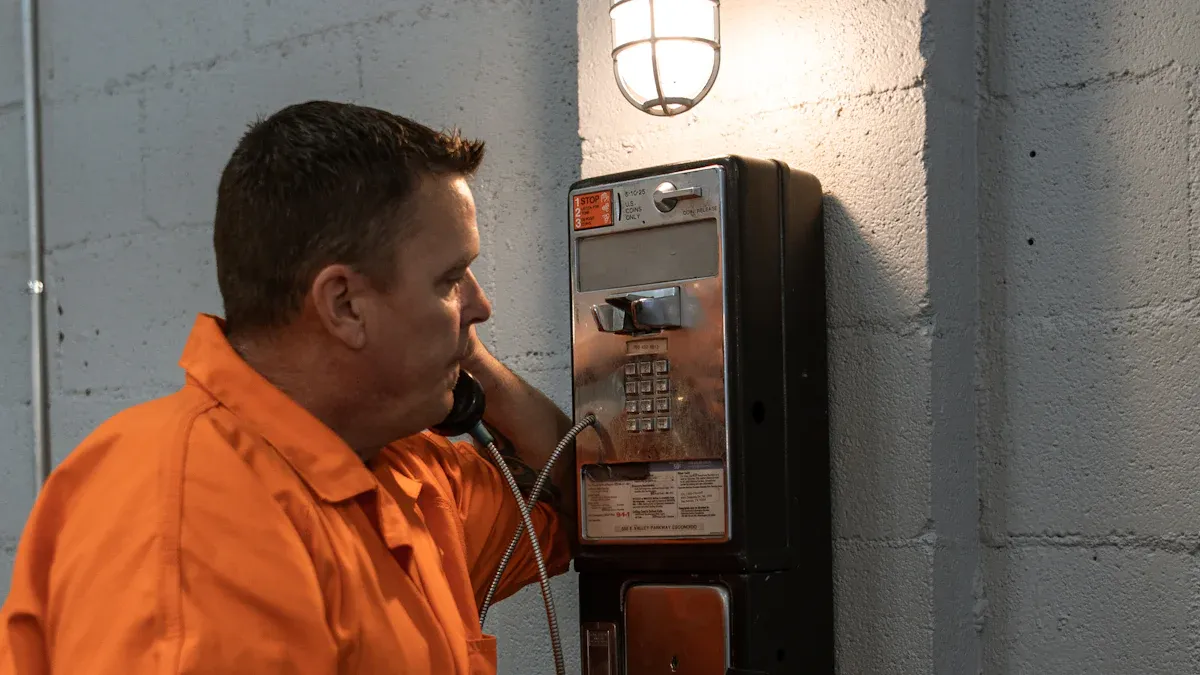Modern prison telephone systems use advanced encryption and robust hardware to block unauthorized access. Facilities rely on secure jail telephone networks, which deliver stable connections and real-time monitoring. Reliable communication technology helps staff protect inmates and respond quickly during emergencies.
Key Takeaways
- Prison communication systems use strong encryption and tamper-resistant hardware to keep calls and data safe from unauthorized access.
- Real-time monitoring and strict access controls help staff quickly detect and stop suspicious activity, keeping the system secure and reliable.
- Integrating communication tools with emergency alerts and training staff improves response times and overall safety inside correctional facilities.
Challenges in Prison Communication

Security Risks and Contraband Devices
Correctional facilities face constant threats from contraband devices. Inmates often attempt to smuggle in cell phones, drugs, and even weapons. These items can disrupt order and compromise safety. The National Institute of Justice (NIJ) highlights several key points about contraband risks and detection:
- Facilities encounter a range of contraband, including illicit weapons, drugs, and cell phones.
- Detection technologies include handheld scanners, walk-through devices, and radio frequency tools for cell phone detection.
- Drug management uses X-ray scanners and chemical detection at entry points.
- Digitizing mail helps reduce drug smuggling through letters and packages.
- New threats, such as drones delivering contraband, require multilayered detection strategies.
Facilities must adapt quickly as inmates find new ways to bypass security. Staff rely on advanced detection tools and strict protocols to limit these risks.
Connectivity and Reliability Concerns
Reliable communication systems are essential in correctional settings. Staff need stable connections to coordinate daily operations and respond to incidents. Outdated infrastructure or poor network coverage can cause dropped calls or delays. These issues may lead to confusion or missed information. Upgrading hardware and using secure networks help maintain consistent service. Facilities that invest in modern systems see fewer disruptions and improved safety.
Emergency Response Limitations
During emergencies, every second counts. Delays in communication can put lives at risk. Some facilities struggle with slow or overloaded systems when incidents occur. Staff may not receive alerts in time, or they may face difficulty reaching the right personnel. Integrating emergency protocols with communication tools improves response times. Facilities that use automated alerts and direct paging systems can act faster and protect everyone inside.
Solutions for Secure, Stable, and Efficient Prison Telephone Systems

Encrypted Networks and Secure Protocols
Correctional facilities depend on encrypted networks to protect sensitive information. Encryption ensures that calls and data sent through prison telephone systems remain confidential. Secure protocols, such as Transport Layer Security (TLS), prevent unauthorized interception and tampering. These protocols also help maintain the integrity of communications between staff and inmates. Facilities that use encrypted networks reduce the risk of eavesdropping and data breaches. Regular updates to encryption standards keep prison telephone systems ahead of emerging threats.
Tamper-Resistant Hardware and Biometric Access
Modern prison telephone systems use tamper-resistant hardware to prevent physical attacks and unauthorized modifications. Facilities install devices with reinforced casings and secure mounting to deter tampering. Biometric access adds another layer of security by verifying the identity of users through fingerprints, facial recognition, or other unique traits.
- Side-channel attacks target the physical properties of biometric systems, making tamper-resistant hardware and encrypted storage essential.
- Intrusion detection systems and secure communication channels protect biometric data and ensure only authorized access.
- The Unified Side-Channel Attack Model (USCA-M) helps identify vulnerabilities and guide defense strategies.
- Deep learning-based classifiers have achieved over 97% accuracy in blocking video-based attacks on biometric systems.
- Blockchain technology secures biometric templates and models, providing alerts for tampering and ensuring fault-tolerant access.
- Liveness detection and multi-factor authentication confirm that biometric input comes from a live person and monitor authentication patterns.
- Physical security measures, including tamper-resistant hardware, protect sensors and data both during transmission and storage.
- Biometric data is stored as encrypted mathematical representations, not raw images, using one-way hashing and encryption.
- Trusted Platform Modules (TPMs) offer tamper resistance and secure biometric data against physical and software attacks.
- On-device biometric processing limits exposure to network threats and gives users more control over their data.
- Compliance with regulations like GDPR and CCPA ensures user consent, data minimization, and rights to access or deletion.
These measures make prison telephone systems more secure and resilient against both physical and digital threats.
Real-Time Monitoring and Access Controls
Facilities use real-time monitoring to track all activity on prison telephone systems. Monitoring software flags suspicious behavior, such as unusual call patterns or attempts to access restricted numbers. Access controls limit who can use the system and what features they can access. Administrators assign permissions based on roles, ensuring that only authorized staff and inmates can initiate or receive calls. Real-time alerts allow staff to respond quickly to potential security breaches. This approach helps maintain order and prevents misuse of communication tools.
Integration with Emergency and Paging Systems
Prison telephone systems now integrate with emergency and paging platforms to improve response times. Centralized communication platforms combine voice, video, and data channels into a single interface. This setup enhances situational awareness and allows staff to coordinate responses more effectively. Wearable panic buttons with real-time location tracking help security teams locate officers in distress quickly. Integration with video surveillance and access control systems creates a unified security environment. Advanced intercom and paging systems provide instant, facility-wide communication, ensuring that staff can relay emergency alerts without delay. These improvements support staff safety and operational control, reducing the risk of harm during critical incidents.
User Training and Operational Best Practices
Staff training and adherence to operational best practices play a vital role in maintaining secure and efficient prison telephone systems.
- A documented case study shows that communication failures can lead to tragic outcomes and legal liability, highlighting the need for clear, accurate, and timely communication among correctional staff.
- Best practices include clear documentation, following communication protocols, and fostering mutual respect, which together enhance safety, security, and legal protection.
- Commonsense rules stress the importance of legible, accurate, and prompt reporting, assertive communication, and awareness that communications may be reviewed in legal or administrative contexts.
- Training in oral, written, non-verbal, and electronic communication methods improves professionalism and operational efficiency.
- Proper training in communication skills and operational best practices directly impacts the safety and efficiency of prison operations, reducing risks of security failures and liability.
Facilities that invest in ongoing training and enforce best practices see fewer incidents and smoother daily operations. Staff who understand the importance of secure communication help protect both inmates and colleagues.
Layered security and reliable prison telephone technology drive safer, more efficient correctional facilities. The global jail management market’s growth highlights this trend. Niagara County Correctional Facility saw a 22% drop in infractions after adopting secure tablets, showing how advanced communication tools improve safety, reduce paperwork, and support effective facility management.
FAQ
How do prison telephone systems prevent unauthorized access?
Prison telephone systems use encrypted networks, biometric authentication, and real-time monitoring. These features block unauthorized users and protect sensitive information.
What happens if a communication device fails during an emergency?
Staff rely on backup systems and integrated paging platforms. These tools ensure rapid alerts and maintain communication, even if the main device fails.
Can inmates use prison communication systems for personal calls?
Facilities allow monitored personal calls under strict rules. Staff review call logs and recordings to prevent misuse or security breaches.

